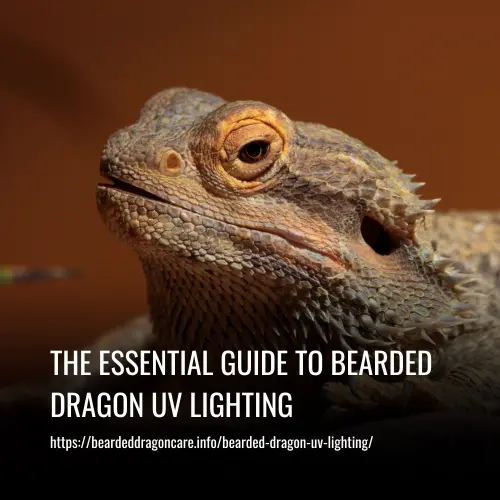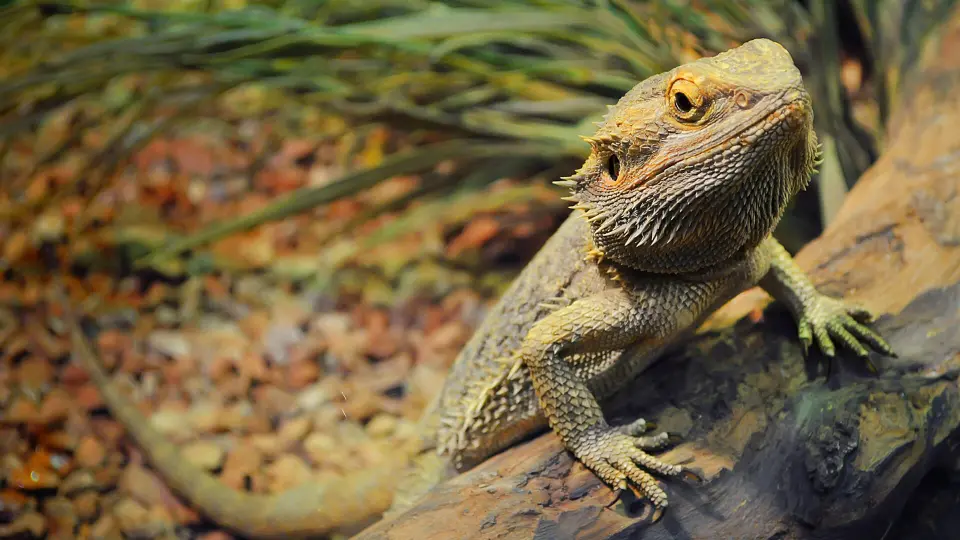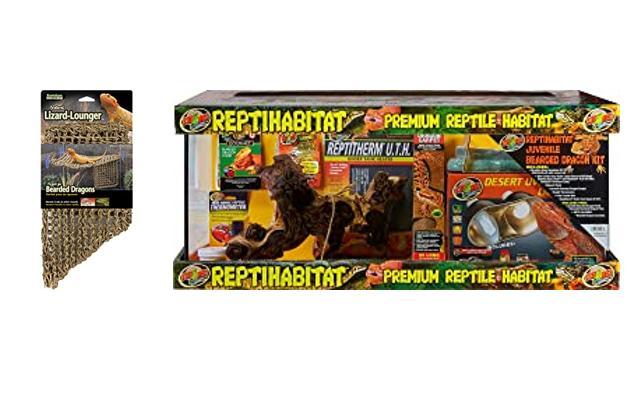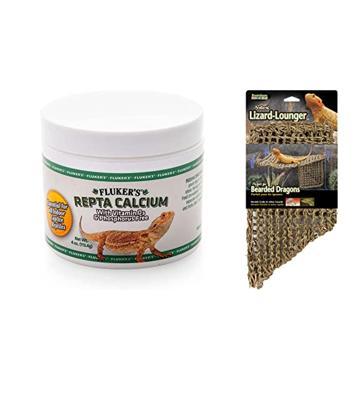Bearded dragons are a popular pet lizard species. Owning a bearded dragon requires many responsibilities, from providing the correct temperature in the environment to giving them access to UV lighting.
UV lighting is essential for any Beardie owner to understand. It’s linked to your pet’s nutrition, energy, and overall health. In this article, we’ll help you understand what UV lighting is and why it matters so much for Bearded Dragons.
UV lighting is essential for bearded dragons because it helps them synthesize Vitamin D3, which is necessary for proper calcium absorption and bone growth.
We’ll explain in depth the type of UV lighting you need, the duration they should spend under its light, and other key facts about the importance of UV lighting for Bearded Dragons.

Bearded Dragon UV Lighting
Being desert animals, Bearded dragon bask almost all day in the hot sun. The sun not only supplies their temperature requirements but emits ultraviolet rays. Because pet Bearded dragons are generally not kept outside in the desert sun, artificial ultraviolet lighting needs to be supplied.
Also, see why Bearded dragons need UV lighting for more information. Natural ultraviolet rays are blocked out by walls and even windows. There are two options when it comes to supplying pet Bearded dragons with adequate UV:
- Through artificial UV lighting
- Through natural, unfiltered sunlight (usually by placing them outside)
When compared with artificial ultraviolet, natural ultraviolet lighting via sunshine is always better. Even if artificial UV lighting is used, Bearded dragons must still be allowed natural, non-filtered sunlight for one to two hours per day.
Artificial UV lighting
Artificial ultraviolet light will be commonly used within enclosures. For this, a full spectrum reptile or, more specifically, Bearded dragon UV light should be installed. These lights are commercially available from specialized pet shops and are available in either fluorescent tubes, mercury vapor floodlights, or spotlights. The intensity of these UV lights, indicated on the packaging, should be 8% or higher. Most commercial Bearded dragon UV lights will mainly emit UVB with little quantities of UVA.
UV lighting should be mounted no more than 30 cm / 12 ” above the main basking area. Closer is better, but not too close as to cause thermal wounds. Generally, UV lighting should be replaced every six months (depending on the manufacturer’s recommendation). All lights (including basking/heating lights) should be on for about fourteen hours per day. An electrical timer can be used for this purpose.
Natural sunlight
As mentioned earlier, it is still recommended that a Bearded dragon is exposed to natural UV, even if ‘adequate’ artificial UV lighting is used. Natural sunshine will expose a Bearded dragon to both UVA and UVB rays. Any natural exposure is better than nothing, but more UV is better.
Why Does My Bearded Dragon Need Uv Light?
The purpose of providing UVB lighting to a bearded dragon’s vivarium is extremely important, as it allows your pet to absorb the Ultraviolet rays that mimic natural sunlight. This helps them to create and regulate their own healthy levels of vitamin D3.
UVB light is essential for the growth and development of a bearded dragon, helping with its bones, shell, and overall health. It also helps them absorb essential nutrients from their food while they’re in captivity, which can help reduce potential health risks.
Not only this, but UVB lighting also regulates their sleep cycles as well as providing an extra source of heat which will help keep them warm during cold nights. So if you have a pet reptile like a bearded dragon or any other kind of reptile then it’s well worth making sure that you provide them with the correct lighting for their wellbeing!
Why Is Vitamin D3 Important For My Bearded Dragon?
Vitamin D3 is an essential vitamin for the health of your bearded dragon. Without Vitamin D3, your reptile would have difficulty absorbing essential minerals such as calcium – putting your pet at risk for developing serious health conditions like a metabolic bone disease.
While it’s important to provide the correct UV light and supplements like calcium powder to your bearded dragon, in order for them to properly absorb those nutrients, they need adequate Vitamin D3.
That’s why it’s essential that you get the right amount of this vital vitamin into their diet in order to keep them happy and healthy.
How Much Uvb Does My Bearded Dragon Need?
Bearded dragons need specific levels of UVB in order to thrive and remain healthy. Fortunately, it’s easy to measure the amount of UVB they need by using a UV meter known as Solarmeter 6.5. This device measures the UV index which should be between 4 to 6 for optimal health in these reptiles kept in captivity.
To ensure that your bearded dragon is getting the most naturalistic representation of sunlight possible – particularly when it comes to the UV spectrum – you need to get the right type of bulb for their enclosure.
Not all bulbs are created equally, so advertising output (like 10%, 12%, etc.) isn’t enough information for us to make an informed choice about what type of bulb we should buy. Having a UV meter is essential for understanding exactly how much Uvb your bearded dragon needs and making sure that your reptile is getting the proper support to stay healthy!
Do You Turn Off UVB At Night?
Bearded dragons don’t need any source of UVA or UVB once the sun has set. Therefore, pet owners need to make sure to switch off their heat lamps and UVB lights at night.
Doing so helps your bearded dragon properly rest; leaving these bulbs on will make them think it’s still daylight, which can really mess with their sleeping cycle.
It’s also important to keep the lights on an hour after they’ve finished eating before bedtime. This way they’ll have enough time to digest their food properly before settling down for the night.
So when it’s time to turn out the lights, remember that your pet will thank you if you switch off their UVA and UVB sources!
How to Mount UVB Light in Tank
If you’re looking to mount a UVB bulb in your bearded dragon’s tank, then it’s easy! Make sure to mount your UVB bulb INSIDE the tank rather than outside. This is because when placed outside the tank, the light can weaken due to mesh lids, thus reducing absorption by your beardie.
Additionally, put the UVB lamp at the side of the tank closest to the basking bulb. The best size fixture for your tank is one that spans about 2/3 of its total length. So if you have a 51-inch long tank, get yourself a 34-inch long fixture and bulb.
The remaining 1/3 section without any UVB will become the cool end of your tank and should be placed on the opposite end of the basking bulb. And that’s it: you now know how easy it is to install a UVB light in your bearded dragon’s enclosure.
UVB Replacement Schedule
One of the most important things to remember when it comes to caring for your bearded dragon is that UVB lamps must be replaced regularly in order to continue working properly.
Simply seeing visible light emanating from the lamp is not enough to tell you that it’s still providing adequate UVB coverage. Investing in a Solarmeter 6.5, which you can use to track the UVI (UV Index) within the enclosure, is highly recommended for keeping tabs on what your beardie is actually being exposed to.
Ideally, optimal health and well-being for a bearded dragon comes with having a UVI gradient of anywhere from 0 all the way up to 4-6, depending on their pigmentation.
However, some morphs like hypomelanistic albino or translucent may need even lower levels and should be exposed to no more than 3 UVI in the basking area. It’s also good practice to have UVB bulbs spanning only 1/2 of the length of their enclosure instead of 2/3.
- Mercury vapor bulbs — every 6-12 months, depending on the manufacturer
- T8 fluorescent — every 6 months
- T5 fluorescent — every 12 months
By following these guidelines you can ensure that your beardie will remain happy and healthy!
Creating the Perfect Environment with UV Lighting for Your Bearded Dragon
Creating the perfect environment for your bearded dragon requires more than just providing them with a warm basking spot and plenty of food. UV lighting is also essential for their health and wellbeing, as it helps to regulate their metabolism, digestion, and even reproduction.
When setting up the perfect environment for your bearded dragon, you’ll need to make sure that you have both UVA and UVB lighting in the enclosure. UVA lighting helps to stimulate their appetite and activity levels, while UVB lighting is essential for the synthesis of Vitamin D3, which is necessary for calcium absorption and bone health.

Where should I put my UV light?
It’s important to know where to place your UV light when you have a bearded dragon. The best location is on the ceiling of the vivarium and as far away from the animal as possible. That way, your bearded dragon gets similar levels of UVB that they would if they were in direct sunlight, but without the risk of eye damage due to glare.
Bearded dragons are adapted to living under the bright overhead sun because their eyes are protected by a protruding orbital bone structure. However, this offers them little protection from artificial lights set up horizontally in front of them.
Therefore, it’s best to use linear UV tubes like Arcadia ProT5s, and build a basking area from the floor with rocks or decorations underneath and around it. This creates a fixed basking zone and enables your beardie to properly regulate its exposure within safe UV light levels when basking.
Does The Size Of My Vivarium Impact What Uv Light I Need?
When considering what kind of UV light to use for your vivarium, its size of it plays an important role. Generally, you want to go for a light that is about 60-80% of the size of the vivarium and place it towards the warm end (where basking lamps are often installed). You also need to make sure it covers at least the length and width of an animal from nose to vent.
For example, if your vivarium is 120x60x60cm (4x2x2ft) or bigger, the Arcadia 39w 12% Prot5 UVB lighting system is suitable for it. This size is the minimum size recommended for bearded dragons.
This lamp is capable of providing a UVI level between 4-6 when placed around 30-45 cm away from where your reptile usually sits at the top of its basking area.
Does Basking Distance Matter?
The answer is yes! When it comes to setting up the perfect environment for your bearded dragon, basking distance does matter.
If your vivarium is taller, get a lamp with higher output, like the 14% Arcadia Dragon Lamp. This will give your beardie the correct amount of UVB light at distances between 45-60cm.
In contrast, lower-output systems, such as Arcadia T8 12% or T5 6%, should be placed 25-30cm away when used in shorter vivariums. Please note that while these small or low vivariums may work when something needs to be temporarily set up with limited space—they do not meet current minimum guidelines for keeping bearded dragons in captivity.
As such, we recommend upgrading to a 60cm or taller tank that meets or exceeds the 120x60x60cm minimum.
| Vivarium Size (cm) | UV Light (Our Top Pick) | Basking Distance |
| 120x60x60 | Arcadia ProT5 12% 39w | 30-45cm |
| 150x60x60 | Arcadia ProT5 12% 54w | 30-45cm |
| 120x60x90 | Arcadia ProT5 14% 39w | 45-60cm |
| 150x60x90 | Arcadia ProT5 14% 54w | 45-60cm |
When selecting a UV light for your vivarium setup, keep size and distance in mind. We’ve provided a helpful chart so you can find the top picks for common vivarium sizes (and excluded smaller sizes since they don’t meet guidelines).
Heating
Bearded dragons need heat to regulate their body temperature and stay healthy. They are cold-blooded reptiles, meaning they rely on external sources of heat, like the sun, to keep them warm. Having an overhead heating source is the best way to simulate this.
Providing a temperature gradient in the enclosure is also important for bearded dragons as it allows them to regulate their own body temperatures. The recommended basking surface temperature for bearded dragons is 42-45°C (108-113°F) with lows at night of 50°F.
Other surfaces like rocks and logs can collect more heat than surrounding air, so providing a stone basking surface is ideal for absorbing heat that bearded dragons can use.
- Basking side surface temperature— 108-113°F (42-45°C)
- Cool side surface temperature — 77-85°F (25-29°C)
- Air temperature gradient — 72-99°F (22-37°C)
- Nighttime — 55-75°F (12-24°C)
Whether you’re just starting out with your first bearded dragon or planning ahead for his future care, you’ll want to make sure he has access to plenty of “sunshine” in order to thrive! With the right heating setup, you can keep your pet beardie happy and healthy throughout all life stages.
Conclusion:
Having the proper UV light for your pet bearded dragon can be the difference between a healthy, long life and an unhappy one. Lighting and heating systems provide the essential components to simulate their natural habitat in captivity, providing them with the necessary warmth and UVA/UVB lights to help ensure they have all that they need to live properly.
Keep your bearded dragon happy and healthy by providing them with these essentials!

